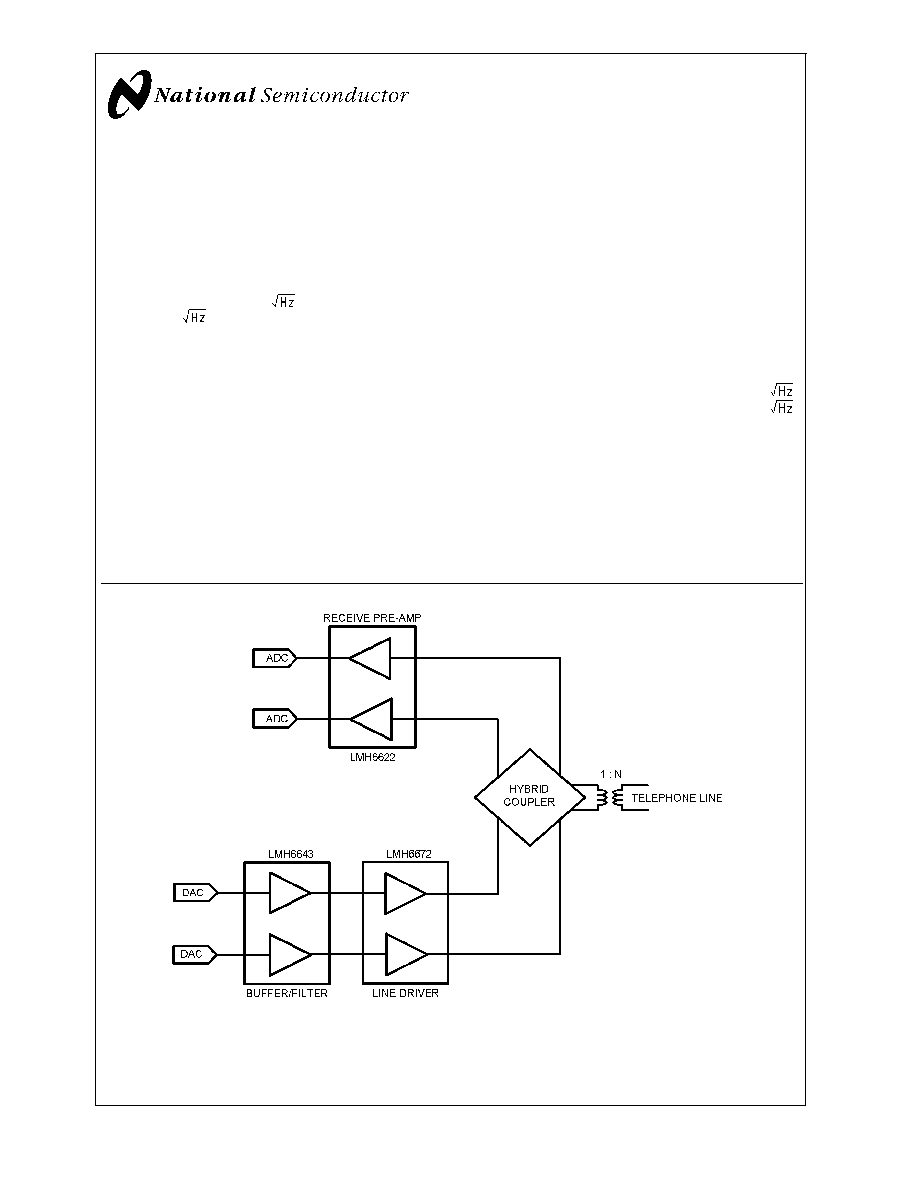
LMH6622
Dual Wideband, Low Noise, 160MHz, Operational
Amplifiers
General Description
The LMH6622 is a dual high speed voltage feedback opera-
tional amplifier specifically optimized for low noise. A voltage
noise specification of 1.6nV/
, a current noise specifi-
cation 1.5pA/
, a bandwidth of 160MHz, and a harmonic
distortion specification that exceeds 90dBc combine to make
the LMH6622 an ideal choice for the receive channel ampli-
fier in ADSL, VDSL, or other xDSL designs. The LMH6622
operates from
±
2.5V to
±
6V in dual supply mode and from
+5V to +12V in single supply configuration. The LMH6622 is
stable for A
V
2 or A
V
-1. The fabrication of the LMH6622
on National Semiconductor's advanced VIP10 process en-
ables excellent (160MHz) bandwidth at a current consump-
tion of only 4.3mA/amplifier. Packages for this dual amplifier
are the 8-lead SOIC and the 8-lead MSOP.
Features
V
S
=
±
6V, T
A
= 25∞C, Typical values unless specified
n
Bandwidth (A
V
= +2)
160MHz
n
Supply Voltage Range
±
2.5V to
±
6V
+5V to +12
n
Slew rate
85V/µs
n
Supply current
4.3mA/amp
n
Input common mode voltage
-4.75V to +5.7V
n
Output Voltage Swing (R
L
= 100
)
±
4.6V
n
Input voltage noise
1.6nV/
n
Input current noise
1.5pA/
n
Linear output current
90mA
n
Excellent harmonic distortion
90dBc
Applications
n
xDSL receiver
n
Low noise instrumentation front end
n
Ultrasound preamp
n
Active filters
n
Cellphone basestation
20029226
xDSL Analog Front End
February 2002
LMH6622
Dual
W
ideband,
Low
Noise,
160MHz,
Operational
Amplifiers
© 2002 National Semiconductor Corporation
DS200292
www.national.com
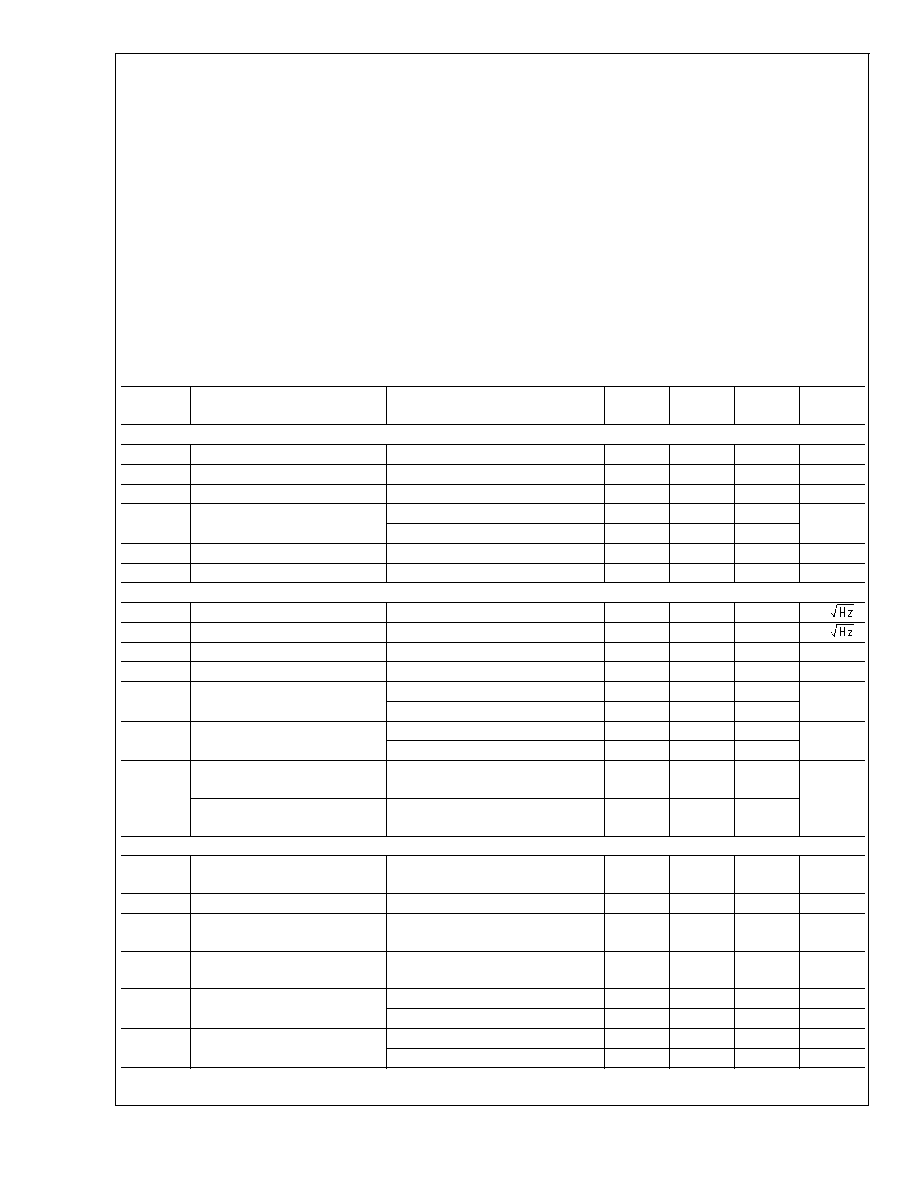
Absolute Maximum Ratings
(Note 1)
If Military/Aerospace specified devices are required,
please contact the National Semiconductor Sales Office/
Distributors for availability and specifications.
ESD Tolerance
Human Body Model
2kV (Note 2)
Machine Model
200V (Note 2)
V
IN
Differential
±
1.2V
Supply Voltage (V
+
≠ V
-
)
13.2V
Voltage at Input Pins
V
+
+0.5V, V
-
-0.5V
Soldering Information
Infrared or Convection (20 sec)
235∞C
Wave Soldering (10 sec)
260∞C
Storage Temperature Range
-65∞C to +150∞C
Junction Temperature (Note 4)
+150∞C
Operating Ratings
(Note 1)
Supply Voltage (V
+
≠ V
-
)
±
2.25V to
±
6V
Junction Temperature Range
(Note 3), (Note 4)
-40∞C to +85∞C
Package Thermal Resistance (Note 4) (
JA
)
8-pin SOIC
166∞C/W
8-pin MSOP
211∞C/W
±
6V Electrical Characteristics
Unless otherwise specified, T
J
= 25∞C, V
+
= 6V, V
-
= -6V, V
CM
= 0V, A
V
= +2, R
F
= 500
, R
L
= 100
. Boldface limits apply
at the temperature extremes.
Symbol
Parameter
Conditions
Min
(Note 6)
Typ
(Note 5)
Max
(Note 6)
Units
Dynamic Performance
f
CL
-3dB BW
V
O
= 200mV
PP
160
MHz
BW
0.1dB
0.1dB Gain Flatness
V
O
= 200mV
PP
30
MHz
SR
Slew Rate (Note 8)
V
O
= 2V
PP
85
V/µs
TS
Settling Time
V
O
= 2V
PP
to
±
0.1%
40
ns
V
O
= 2V
PP
to
±
1.0%
35
Tr
Rise Time
V
O
= 0.2V Step, 10% to 90%
2.3
ns
Tf
Fall Time
V
O
= 0.2V Step, 10% to 90%
2.3
ns
Distortion and Noise Response
e
n
Input Referred Voltage Noise
f = 100kHz
1.6
nV/
i
n
Input Referred Current Noise
f = 100kHz
1.5
pA/
DG
Differential Gain
R
L
= 150
, R
F
= 470
, NTSC
0.03
%
DP
Differential Phase
R
L
= 150
, R
F
= 470
, NTSC
0.03
deg
HD2
2
nd
Harmonic Distortion
f
c
= 1MHz, V
O
= 2V
PP
, R
L
= 100
-90
dBc
f
c
= 1MHz, V
O
= 2V
PP
, R
L
= 500
-100
HD3
3
rd
Harmonic Distortion
f
c
= 1MHz, V
O
= 2V
PP
, R
L
= 100
-94
dBc
f
c
= 1MHz, V
O
= 2V
PP
, R
L
= 500
-100
MTPR
Upstream
V
O
= 0.6 V
RMS
, 26kHz to 132kHz
(see test circuit 5)
-78
dBc
Downstream
V
O
= 0.6 V
RMS
, 144kHz to 1.1MHz
(see test circuit 5)
-70
Input Characteristics
V
OS
Input Offset Voltage
V
CM
= 0V
-1.2
-2
+0.2
+1.2
+2
mV
TC V
OS
Input Offset Average Drift
V
CM
= 0V (Note 7)
-2.5
µV/∞C
I
OS
Input Offset Current
V
CM
= 0V
-1
-1.5
-0.04
1
1.5
µA
I
B
Input Bias Current
V
CM
= 0V
4.7
10
15
µA
R
IN
Input Resistance
Common Mode
17
M
Differential Mode
12
k
C
IN
Input Capacitance
Common Mode
0.9
pF
Differential Mode
1.0
pF
LMH6622
www.national.com
2
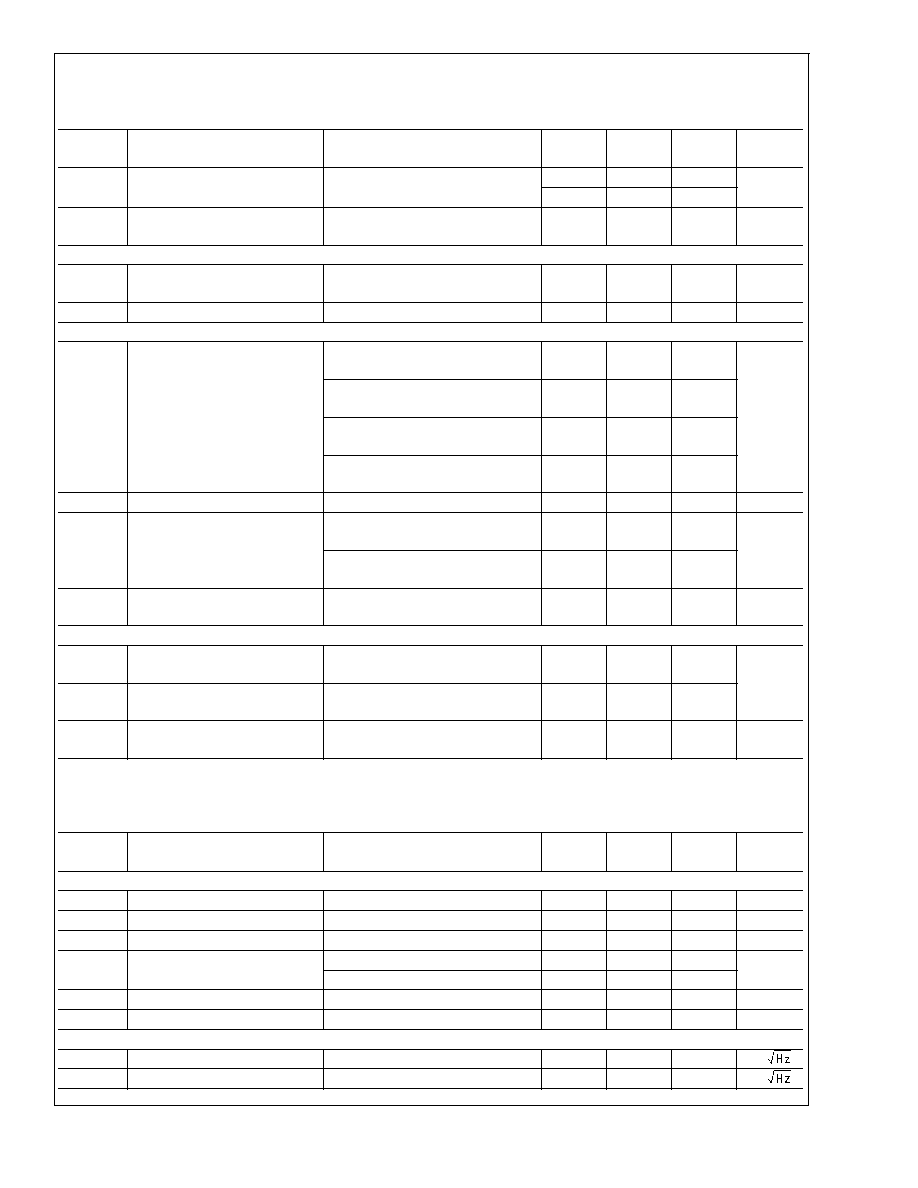
±
6V Electrical Characteristics
(Continued)
Unless otherwise specified, T
J
= 25∞C, V
+
= 6V, V
-
= -6V, V
CM
= 0V, A
V
= +2, R
F
= 500
, R
L
= 100
. Boldface limits apply
at the temperature extremes.
Symbol
Parameter
Conditions
Min
(Note 6)
Typ
(Note 5)
Max
(Note 6)
Units
CMVR
Input Common Mode Voltage
Range
CMRR
60dB
-4.75
-4.5
V
5.5
+5.7
CMRR
Common-Mode Rejection Ratio
Input Referred,
V
CM
= -4.2 to +5.2V
80
75
100
dB
Transfer Characteristics
A
VOL
Large Signal Voltage Gain
V
O
= 4V
PP
74
70
83
dB
X
t
Crosstalk
f = 1MHz
-75
dB
Output Characteristics
V
O
Output Swing
No Load, Positive Swing
4.8
4.6
5.2
V
No Load, Negative Swing
-5.0
-4.6
-4.4
R
L
= 100
, Positive Swing
4.0
3.8
4.6
R
L
= 100
, Negative Swing
-4.6
-4
-3.8
R
O
Output Impedance
f = 1MHz
0.08
I
SC
Output Short Circuit Current
Sourcing to Ground
V
IN
= 200mV (Note 3), (Note 9)
100
135
mA
Sinking to Ground
V
IN
= -200mV (Note 3), (Note 9)
100
130
I
OUT
Output Current
Sourcing, V
O
= +4.3V
Sinking, V
O
= -4.3V
90
mA
Power Supply
+PSRR
Positive Power Supply
Rejection Ratio
Input Referred,
V
S
= +5V to +6V
80
74
95
dB
-PSRR
Negative Power Supply
Rejection Ratio
Input Referred,
V
S
= -5V to -6V
75
69
90
I
S
Supply Current (per amplifier)
No Load
4.3
6
6.5
mA
±
2.5V Electrical Characteristics
Unless otherwise specified, all limits guaranteed for T
J
= 25∞C, V
+
= 2.5V, V
-
= -2.5V, V
CM
= 0V, A
V
= +2, R
F
= 500
,
R
L
= 100
. Boldface limits apply at the temperature extremes.
Symbol
Parameter
Conditions
Min
(Note 6)
Typ
(Note 5)
Max
(Note 6)
Units
Dynamic Performance
f
CL
-3dB BW
V
O
= 200mV
PP
150
MHz
BW
0.1dB
0.1dB Gain Flatness
V
O
= 200mV
PP
20
MHz
SR
Slew Rate (Note 8)
V
O
= 2V
PP
80
V/µs
T
S
Settling Time
V
O
= 2V
PP
to
±
0.1%
45
ns
V
O
= 2V
PP
to
±
1.0%
40
T
r
Rise Time
V
O
= 0.2V Step, 10% to 90%
2.5
ns
T
f
Fall Time
V
O
= 0.2V Step, 10% to 90%
2.5
ns
Distortion and Noise Response
e
n
Input Referred Voltage Noise
f = 100kHz
1.7
nV/
i
n
Input Referred Current Noise
f = 100kHz
1.5
pA/
LMH6622
www.national.com
3
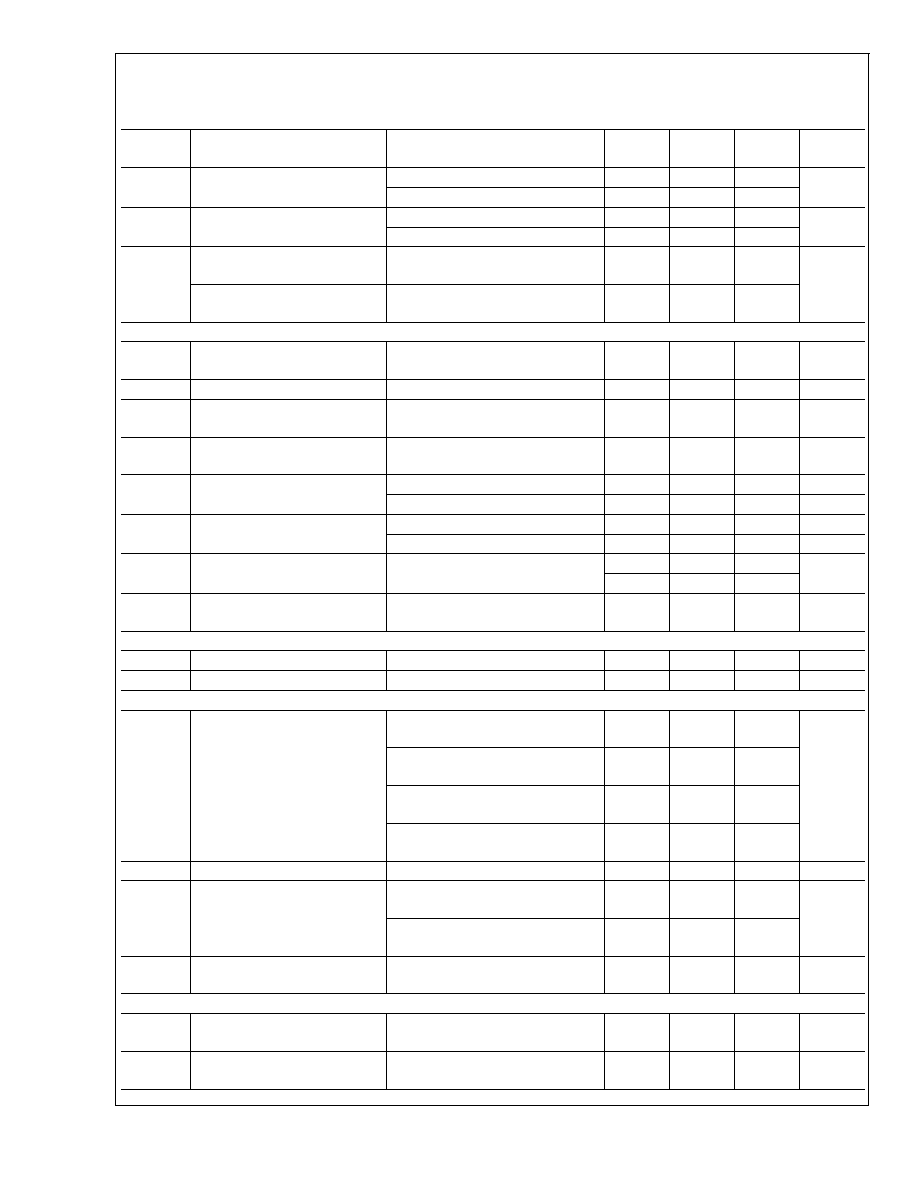
±
2.5V Electrical Characteristics
(Continued)
Unless otherwise specified, all limits guaranteed for T
J
= 25∞C, V
+
= 2.5V, V
-
= -2.5V, V
CM
= 0V, A
V
= +2, R
F
= 500
,
R
L
= 100
. Boldface limits apply at the temperature extremes.
Symbol
Parameter
Conditions
Min
(Note 6)
Typ
(Note 5)
Max
(Note 6)
Units
HD2
2
nd
Harmonic Distortion
fc = 1MHz, V
O
= 2V
PP
, R
L
= 100
-88
dBc
fc = 1MHz, V
O
= 2V
PP
, R
L
= 500
-98
HD3
3
rd
Harmonic Distortion
fc = 1MHz, V
O
= 2V
PP
, R
L
= 100
-92
dBc
fc = 1MHz, V
O
= 2V
PP
, R
L
= 500
-100
MTPR
Upstream
V
O
= 0.4V
RMS
,26kHz to 132kHz
(see test circuit 5)
-76
dBc
Downstream
V
O
= 0.4V
RMS
,144kHz to 1.1MHz
(see test circuit 5)
-68
Input Characteristics
V
OS
Input Offset Voltage
V
CM
= 0V
-1.5
-2.3
+0.3
+1.5
+2.3
mV
TC V
OS
Input Offset Average Drift
V
CM
= 0V (Note 7)
-2.5
µV/∞C
I
OS
Input Offset Current
V
CM
= 0V
-1.5
-2.5
+0.01
1.5
2.5
µA
I
B
Input Bias Current
V
CM
= 0V
4.6
10
15
µA
R
IN
Input Resistance
Common Mode
17
M
Differential Mode
12
k
C
IN
Input Capacitance
Common Mode
0.9
pF
Differential Mode
1.0
pF
CMVR
Input Common Mode Voltage
Range
CMRR
60dB
-1.25
-1
V
2
+2.2
CMRR
Common Mode Rejection Ratio
Input Referred,
V
CM
= -0.7 to +1.7V
80
75
100
dB
Transfer Characteristics
A
VOL
Large Signal Voltage Gain
V
O
= 1V
PP
74
82
dB
X
t
Crosstalk
f = 1MHz
-75
dB
Output Characteristics
V
O
Output Swing
No Load, Positive Swing
1.4
1.2
1.7
V
No Load, Negative Swing
-1.5
-1.2
-1
R
L
= 100
, Positive Swing
1.2
1
1.5
R
L
= 100
, Negative Swing
-1.4
-1.1
-0.9
R
O
Output Impedance
f = 1MHz
0.1
I
SC
Output Short Circuit Current
Sourcing to Ground
V
IN
= 200mV (Note 3), (Note 9)
100
137
mA
Sinking to Ground
V
IN
= -200mV (Note 3), (Note 9)
100
134
I
OUT
Output Current
Sourcing, V
O
= +0.8V
Sinking, V
O
= -0.8V
90
mA
Power Supply
+PSRR
Positive Power Supply Rejection
Ratio
Input Referred,
V
S
= +2.5V to +3V
78
72
93
dB
-PSRR
Negative Power Supply
Rejection Ratio
Input Referred,
V
S
= -2.5V to -3V
75
70
88
dB
LMH6622
www.national.com
4
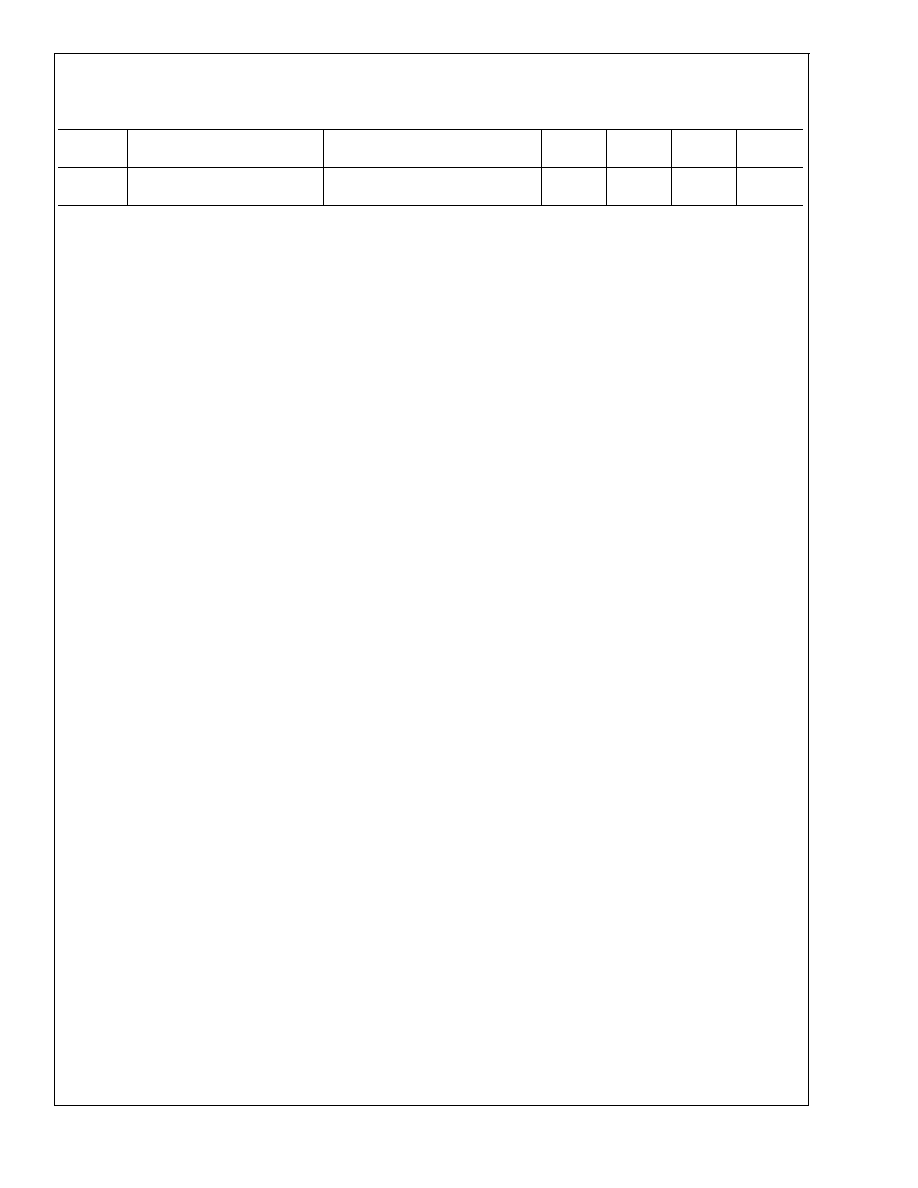
±
2.5V Electrical Characteristics
(Continued)
Unless otherwise specified, all limits guaranteed for T
J
= 25∞C, V
+
= 2.5V, V
-
= -2.5V, V
CM
= 0V, A
V
= +2, R
F
= 500
,
R
L
= 100
. Boldface limits apply at the temperature extremes.
Symbol
Parameter
Conditions
Min
(Note 6)
Typ
(Note 5)
Max
(Note 6)
Units
I
S
Supply Current (per amplifier)
No Load
4.1
5.8
6.4
mA
Note 1: Absolute Maximum Ratings indicate limits beyond which damage to the device may occur. Operating Ratings indicate conditions for which the device is
intended to be functional, but specific performance is not guaranteed. For guaranteed specifications and the test conditions, see the Electrical Characteristics.
Note 2: Human body model, 1.5k
in series with 100pF. Machine model, 0
in series with 200pF.
Note 3: Applies to both single-supply and split-supply operation. Continuous short circuit operation at elevated ambient temperature can result in exceeding the
maximum allowed junction temperature of 150∞C.
Note 4: The maximum power dissipation is a function of T
J(MAX)
,
JA
and T
A
. The maximum allowable power dissipation at any ambient temperature is P
D
=
(T
J(MAX)
- T
A
)/
JA
. All numbers apply for packages soldered directly onto a PC board.
Note 5: Typical values represent the most likely parametric norm.
Note 6: All limits are guaranteed by testing or statistical analysis.
Note 7: Offset voltage average drift is determined by dividing the change in V
OS
at temperature extremes into the total temperature change.
Note 8: Slew rate is the slowest of the rising and falling slew rates.
Note 9: Short circuit test is a momentary test. Output short circuit duration is infinite for V
S
±
2.5V, at room temperature and below. For V
S
>
±
2.5V, allowable short
circuit duration is 1.5ms.
LMH6622
www.national.com
5




